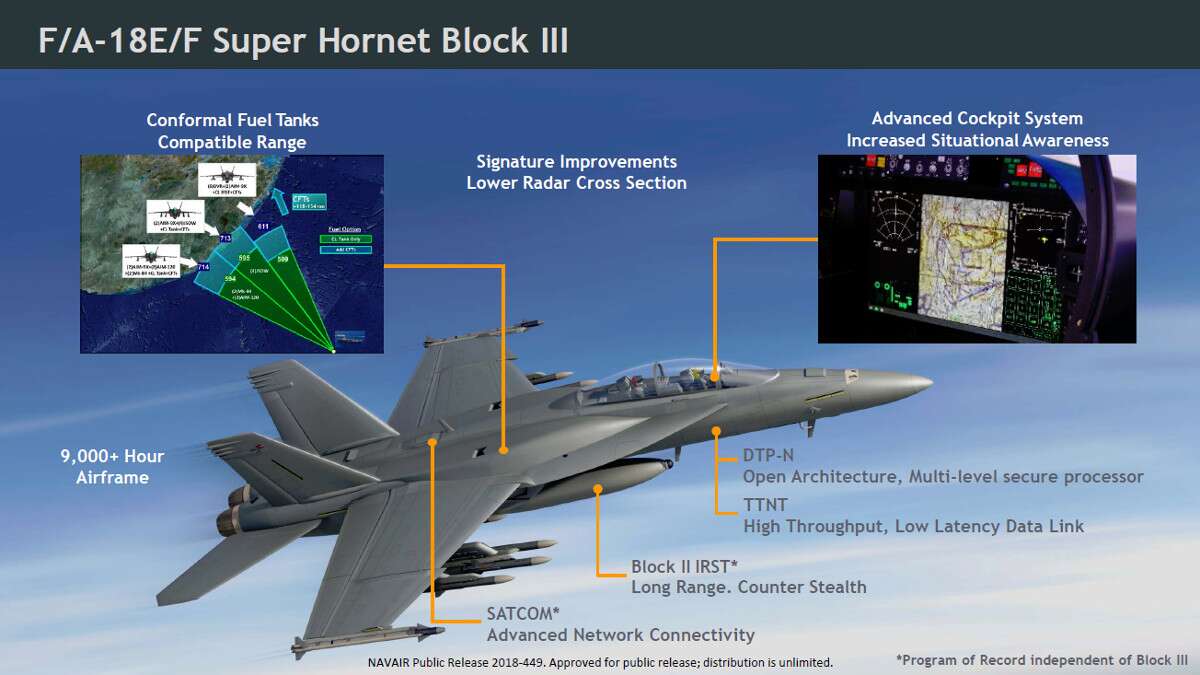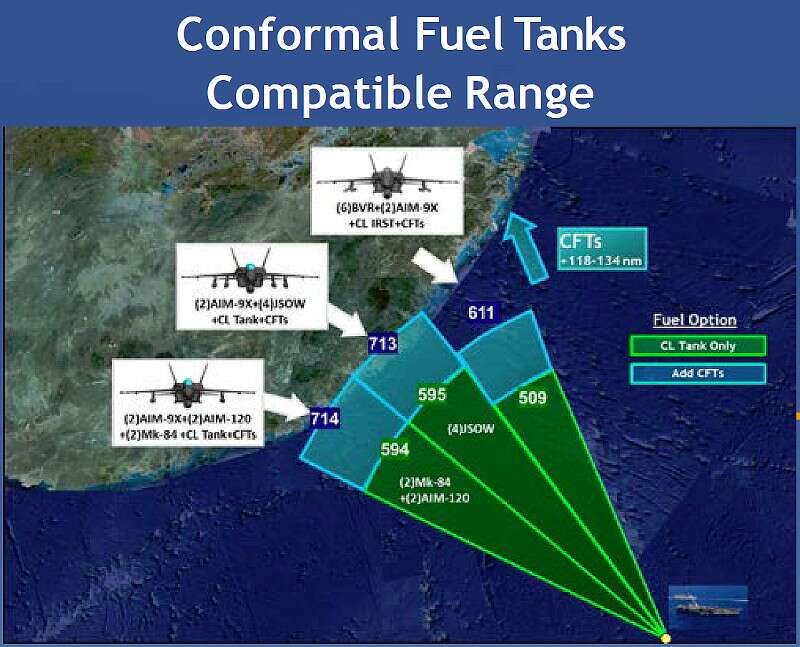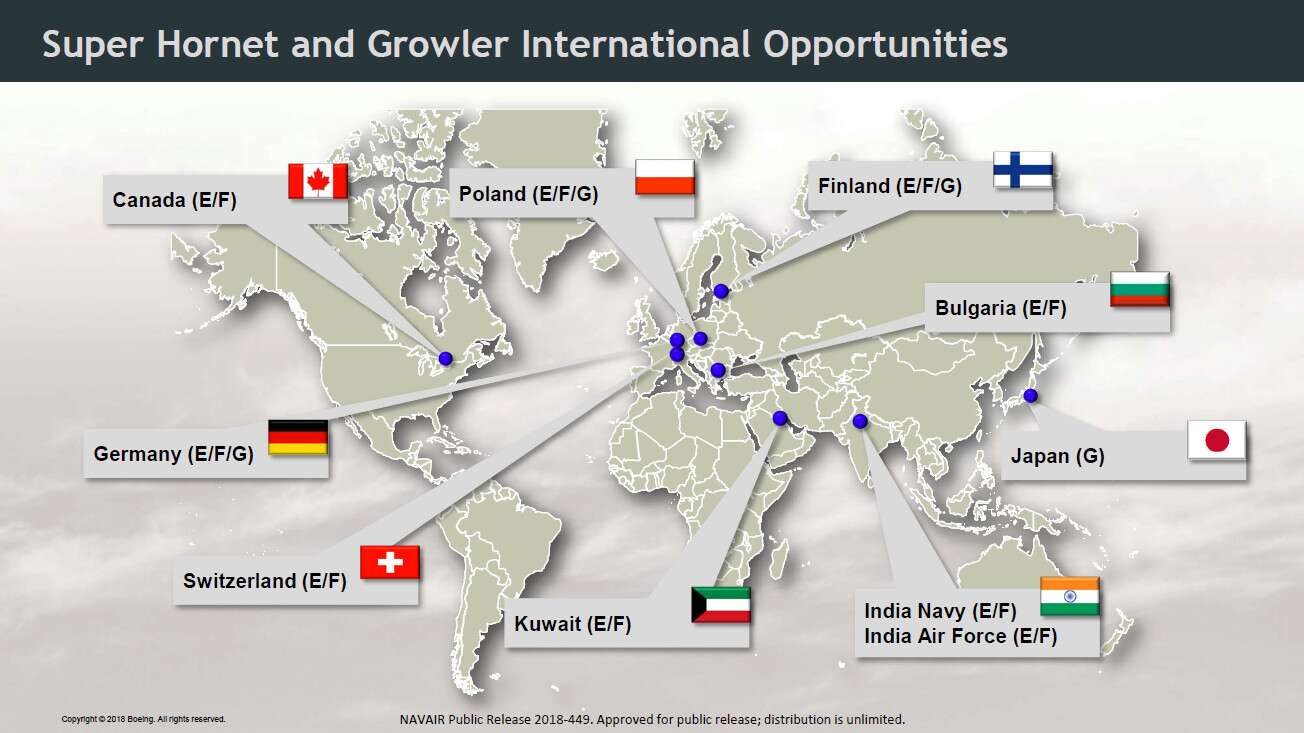
Posted on 05/23/2018 8:10:46 PM PDT by sukhoi-30mki
Boeing is pushing ahead with the Block III F/A-18E/F Super Hornet program for the U.S. Navy, which includes new build aircraft and upgraded planes, and will significantly enhance the lifespan and capabilities of the jets. At the same time, there are no formal plans to upgrade the fighter's engines or add conformal fuel tanks to the service’s EA-18G electronic warfare aircraft, which could limit Carrier Air Wings’ ability to take full advantage of the added capabilities.
On May 23, 2018, Boeing hosted a media day at its offices in Washington, D.C. to provide the latest updates on the program’s status. According to its latest budget request for the 2019 fiscal year and associated documentation, the Navy intends to purchase 110 new F/A-18E/F aircraft in the Block III configuration over a four year period. The service also plans to upgrade at least a portion of its 540 existing Super Hornets to the new standard as part of a service life modification program, or SLM, that will run through at least 2025.
Boeing says it will deliver two test jets to the Navy in 2019 ahead of the first of the new production aircraft, which will begin arriving between 2020 and 2021. The service expects to begin using the Block III Super Hornet operationally by 2022 and hopes to have the equivalent of one squadron of the aircraft for each of its nine Carrier Air Wings by 2024. The goal is for there to be two squadrons of the jets per Carrier Air Wing by 2027.
“Super Hornet – 100 percent of the striking force of the Carrier Air Wing today,” Dan Gillian, vice president of Boeing’s F/A-18 program, said during his press briefing. “There is no retirement date for the Block III Super Hornet.”

BOEING
An artist's conception of a Block III F/A-18F Super Hornet.
At present, the Navy plans to fly a mix of these jets and F-35Cs for the foreseeable future. The Block III configuration is supposed to ensure the Super Hornets can operate together with the stealthy Joint Strike Fighters in high-end conflicts as threats to the Carrier Air Wing and the aircraft carriers themselves continue to grow.
All of the new Block III Super Hornets will have a lifespan of at least 9,000 flight hours, which is fifty percent greater than that of earlier F/A-18E/F aircraft. The SLM program will extend the life of existing jets out to the same total flight hours.
On top of this, the final versions of the new and upgraded F/A-18E/Fs will feature five major upgrades. These are conformal fuel tanks, a networked infrared search and track (IRST) capability, physical changes and coatings to reduce the radar signature of the aircraft, new mission computers and data links, and a new, single wide-area multi-function display in the cockpit.

BOEING
An overview of the Block III Super Hornet's new features.
The conformal fuel tanks, or CFTs, which Boeing in developing in cooperation with Northrop Grumman, are an extremely important addition to the aircraft in their own right. At their most basic, they extend the range of the Super Hornet and free up underwing space for more ordnance or other stores.
The two CFTs hold slightly less fuel than a pair of 330-gallon drop tanks, but the added aerodynamic efficiency of the arrangement makes up for this, according to Gillian. The new tanks will extend the Block III Super Hornet’s range by between 100 and 120 miles on average, depending on the jet’s exact loadout.
“Also, not having those draggy drop tanks lets you go faster,” Gillian said. “Speed and range come with the conformal fuel tanks, which is critical when you think about the future fight and needing to extend the range of the Carrier Air Wing.”
Gillian added that previous testing with Boeing designed-CFTs during the Advanced Super Hornet program in 2013 had shown that the kinematics remain effectively the same between aircraft with and without the tanks and that there does not appear to be any significant loss of maneuverability with the added feature. The company plans to flight test this existing older design in combination with other Block III upgrades in the near future as a risk-reduction measure.

BOEING
A close-up of the infographic showing difference in ranges between existing Super Hornets and aircraft in the Block III configuration with CFTs when carrying various different kinds of weapons, including the AGM-154 Joint Standoff Weapon, or JSOW.
Unfortunately, new engines for the F/A-18E/F and the EA-18G, another addition that could help build on the added efficiency the CFTs offer, are absent from the Block III program. It remains unclear when and if the Navy might pursue this further upgrade project, which has been under consideration in one form or another since at least 2013.
General Electric has in the past and continues to propose an improved variant of the Super Hornet’s existing F414 engine. Previous “Enhanced Durability” and “Enhanced Performance” concepts featured new fan and compressor components that would variously improve lifespan and performance. The F414-EPE type reportedly offered a 20 percent boost in thrust.
The Navy did include $15 million for research and development into a Super Hornet engine upgrade in its unfunded priorities list for the 2019 fiscal year. However, this is a wishlist the service sends annually to Congress in the hopes lawmakers will allocate additional funds for various projects.
It’s also unclear whether the Navy plans to add CFTs to the EA-18G fleet or include those aircraft in any potential engine upgrades. The Growlers have to carry around jamming pods on their underwing pylons in lieu of drop tanks in order to perform their mission.
As such, the CFTs would be even more essential to extending their range. Adding in more powerful or efficient engines would also be a boon for the aircraft given how generally burdensome their standard loadout is.
Those electronic warfare platforms are only likely to become more critical as time goes on, especially with regards to potential high-end conflict scenarios, and you can read more about their specific jamming and electronic attack capabilities here. But without these updates they might not be able to accompany strike packages of Block III Super Hornets out to their full combat range, reducing the overall effectiveness of the force.
The CFTs won't even be available when the Navy gets its first of the new jets. Boeing says they will be ready by the time the aircraft begin flying operational missions in 2022, according to information the company gave at the media day event.
There was no specific mention of what Block III Super Hornet updates might or might not find their way into the Growler in the future or when that might occur. The company was keen to stress that the complete upgrade package would greatly improve the F/A-18E/F’s survivability and capabilities within the Carrier Air Wing as it exists now and as it transforms in the future with the addition of the F-35 and other new systems.
The exact nature of the Block III’s stealthy airframe enchantments remains unclear. Boeing’s Gillian did mention “simple treatments and coatings” to help reduce the aircraft’s radar cross-section, but did not offer any additional specifics. In the past, he has said these changes could reduce the radar signature of the jets by as much as 10 percent.
There are no plans to give Navy's new and upgraded jets a fully enclosed weapons pod that could further improve the Super Hornet's low-observable characteristics. Boeing had previously proposed this system as part of the Super Hornet International Roadmap and the Advanced Super Hornet concept.
The infrared search and track system (IRST), already in development as part of the earlier Block II upgrade, will give the advanced fourth generation aircraft an additional means to detect hostile low-observable aircraft at long distances. In addition, coupled with the new Distributed Targeting Processor-Networked (DTP-N) and Tactical Targeting Network Technology (TTNT) data link, multiple jets will be able to fuse data from these sensors, as well as others, to form what Boeing and the Navy call a “common tactical picture,” or CTP.
A single Block III Super Hornet will be able to passively scan with the IRST, spot targets, and present the pilot with a rough bearing overlaid on the aircraft’s radar screen. The sensor-fuzed CTP allows two or more aircraft to not only get a bearing on an opponent, but determine their range and altitude. Boeing says this data will be accurate enough to create three-dimensional target tracks and allow F/A-18E/F crews to actually engage their opponents at extended ranges.
The company declined to say how far out the IRST, which the Super Hornets will carry in the front of a modified drop tank, will be able to identify targets. Separately, U.S. Navy Captain David Kindley, the F/A-18 program manager at Naval Air Systems Command, who was also on hand, said the modular nature of the sensor would allow jets to fly with it only as necessary.
“This airplane as it sits looks very much like a high-end air-to-air type fight[er] – God forbid we should be in that place, but that’s kind of what this airplane is designed for,” Kindley said, referring to a model of the Block III Super Hornet next to him at the time. “Tomorrow, if we go to a different place, this is an external tank that can be replaced by a no-kidding external tank that without the first third of it is an IRST. We can put smart air-to-ground ordnance on the aircraft and it can be in a different role.”
Though Gillian and Kindley did not make the case directly, the implication here is clearly that the F/A-18E/F Block III aircraft will give the Carrier Air Wing a cost-effective alternative to the F-35C in low-end conflicts, such as Iraq and Syria. At the same time, though, it will offer a complementary capability of higher end fights against potential near-peer adversaries, such as Russia or China.
To further enhance this flexibility, in addition to the DTP-N and TTNT systems, the Block III aircraft will also have an updated satellite communications system, another hold-over from the Block II program. Information from the aircraft’s own sensors and mission systems, as well as the data it receives from other sources, will feed into different displays on a single 10-inch by 19-inch flat panel touch screen that replaces the existing multi-function displays.
The completely redesigned cockpit architecture, known as the Advanced Cockpit System, will also include additional backup displays and manual buttons in case this single screen fails in part or in full. Dual seat F/A-18Fs will have this functionality in both the front and rear cockpits.
Boeing says it has already been testing the glass cockpit systems in both physical and simulated formats and that it has solicited feedback from various Navy aviators, including elite pilots from the service’s famous Navy Strike Fighter Tactics Instructor program, more commonly known as Topgun. The goal is to have a new user interface that is intuitive and will require as little change to existing training regimens as possible.
Boeing also has other cockpit updates in the works adjacent, but separate to the Block III program, including three-dimensional tonal audio warnings. This means a pilot will not only receive an auditory warning about a potential or incoming threat, but will hear the tone coming from the direction it's coming from. There has also been some investigation into the possibility of adding voice commands to various systems inside the jets, but so the sheer volume of noise inside the cockpit of a modern fighter jet has been a major limiting factor.
The company hopes that all of the Navy’s Block III program and its other associated improvements to the aircraft will make Super Hornet an increasingly attractive option for foreign buyers, as well. Most recently, Boeing finalized a deal to supply 22 F/A-18Es and six F/A-18Fs to Kuwait.
Though Boeing’s Gillian couldn’t say what systems they would have in common with the Navy’s future aircraft, he did say there was some overlap with the Block III jets. In addition, these will be most advanced versions of the aircraft to date when they roll off the production line.
That contract also serves as a bridge to keep the production line hot between the Navy’s most recent orders and those that the service expects to place with funds it receives for the 2019 fiscal year. Beyond that, Boeing says it is either actively competing for bids or is otherwise in discussions with eight other countries over potential Super Hornet or Growler sales.
The biggest potential buyer would be India, which is running tenders for new fighter jets for both its Air Force and Navy, with the former service looking to buy more than 100 new aircraft. In addition, Boeing has announced it could join together with Indian firms Hindustan Aeronautics Limited and Mahindra Defense Systems to manufacture the jets in the country if it wins the contract. We overheard in the lobby ahead of the media day that representatives from the Indian embassy would be arriving later in the day for briefings on Super Hornet.
Other possible customers could include Bulgaria, Canada, Finland, Germany, Japan, Poland, and Switzerland. According to Gillian, Japan has only expressed a preliminary interesting in the EA-18G, though.

BOEING
A map showing countries that Boeing hopes to sell Super Hornets or Growlers to in the future. So far, only Kuwait has committed to purchase any jets.
A number of these competitions are already controversial, however, and may not come to pass in their current form at all. The Indian Air Force is now on the third iteration of its fighter jet replacement program and Boeing almost ended up cut out of the Canadian competition, a saga unto itself, after a trade dispute.
As it stands now, the Navy remains the primary Super Hornet customer and is set to operate the jets for years to come. Whether its commitments to the program expand beyond where they are now, such as adding new engines to the jets or adding conformal fuel tanks to its EA-18Gs, remain to be seen.
That looks like a lot of information for the pilot to track while flying.
I think Israel has been doing the Conformal Tank thing for over 10 years..?
Yeah, not like they can hit “pause” and get their wits about them.
It does indeed look like a lot of information for the pilot which would threaten to saturate the pilot and diminish their situational awareness, and as such, I would think the secret sauce in it would be the software and symbology presenting information to the pilot to reduce that burden.
Let AI help the pilot. Hell, we are there now. We should use it. It is no substitute for a MK1 Human Brain, but it sure can augment one pretty well.
EA-18G Growlers don’t need stealth. They go in ahead of all the other warplanes to fry enemy radar missile sites and destroy launch locations, and fry other communications networks.
During the Gulf Wars, the Air Force wouldn’t fly into Iraq unless they had US Navy EA-6B Prowlers to go in first and do their thing. It was the Prowlers that made the biggest contributions to the very low loss of allied war planes.
Yes, on the F-16I (Block 52). Perhaps the Israelis could help our DOD contractors figure out how to deliver those CFTs in less than four years (!!).
I think conformals on the Growler is more about freeing up the heavy hard points. I would also like to see a lower drag option to the ALQ-99 pod. That thing is drag incarnate.
wonderful...
At the same time, there are no formal plans to upgrade the fighter’s engines or add conformal fuel tanks to the service’s EA-18G electronic warfare aircraft, which could limit Carrier Air Wings’ ability to take full advantage of the added capabilities.
A wealth of information, which I think should be classified, available from the Internet.
 they still need to travel the same distance as the killers
they still need to travel the same distance as the killers
Yes, they do; and they need to be able to fly as fast as the killers. EA-6B Prowler can’t do that.
that’s not the problem, the problem is...
“At the same time, there are no formal plans to upgrade the fighter’s engines or add conformal fuel tanks to the service’s EA-18G electronic warfare aircraft, which could limit Carrier Air Wings’ ability to take full advantage of the added capabilities.”
Not a “new” jet but still takes 6 years to outfit a Naval Squadron?
I guess I don’t understand the complexity involved in modifying an existing airframe.
Disclaimer: Opinions posted on Free Republic are those of the individual posters and do not necessarily represent the opinion of Free Republic or its management. All materials posted herein are protected by copyright law and the exemption for fair use of copyrighted works.